A randomized controlled trial of an extensive lifestyle management intervention (ELMI) following cardiac rehabilitation: study design and baseline data
- PMID: 12473163
- PMCID: PMC149404
- DOI: 10.1186/1468-6708-3-9
A randomized controlled trial of an extensive lifestyle management intervention (ELMI) following cardiac rehabilitation: study design and baseline data
Abstract
Background: Cardiac rehabilitation programs (CRP) represent comprehensive interventions that are typically limited to four months. Following completion of CRP, it appears that risk factors and lifestyle behaviours may deteriorate. The Extensive Lifestyle Management Intervention (ELMI) Following Cardiac Rehabilitation trial will investigate the benefits of a randomized intervention to prevent these adverse changes.
Methods: Patients with ischemic heart disease (IHD) were randomized following a standard CRP to the ELMI or to usual care. The ELMI program is a case-managed intervention aimed at individualizing risk factor and lifestyle management based on current treatment guidelines. The program consists of cardiac rehabilitation sessions, telephone follow-up and risk factor and lifestyle counselling sessions. Health professionals work with participants using behavioural counselling and communications with participants' family physicians. Usual care participants return to their family physicians' care, and come to the study clinic only to undergo annual outcomes assessment. The primary outcome is change in IHD global risk after four years. Secondary outcomes include combined cardiovascular events, health care utilization, lifestyle adherence, quality of life and risk factors.
Results: Over 28 months, 302 men and women were randomized. This represented 29% of the total population screened. The average age of study participants is 64 years, 18% are women, 53% have had a previous myocardial infarction, 73% have undergone previous revascularization and 20% have diabetes mellitus. Ischemic heart disease risk factors for the entire cohort improved significantly after subjects had gone through previous CRPs. Baseline risk factors, lifestyle behaviours and medications were similar between the groups.
Conclusions: This study population is representative of patients completing a standard CRP. Results of the ELMI trial will provide valuable information for the future design of CRPs.
Figures



References
-
- O'Connor GT, Buring JE, Yusuf S, Goldhaber SZ, Olmstead EM, Paffenbarger RS, Hennekens CH. An overview of randomized trials of rehabilitation with exercise after myocardial infarction. Circulation. 1989;80:234–244. - PubMed
-
- Haskell WL, Alderman EL, Fair JM, Maron DJ, Mackey SF, Superko HR, Williams PT, Johnstone IM, Champagne MA, Krauss RM, et al. Effects of intensive multiple risk factor reduction on coronary atherosclerosis and clinical cardiac events in men and women with coronary artery disease. The Stanford Coronary Risk Intervention Project (SCRIP). Circulation. 1994;89:975–990. - PubMed
LinkOut - more resources
Full Text Sources
Research Materials
Miscellaneous

